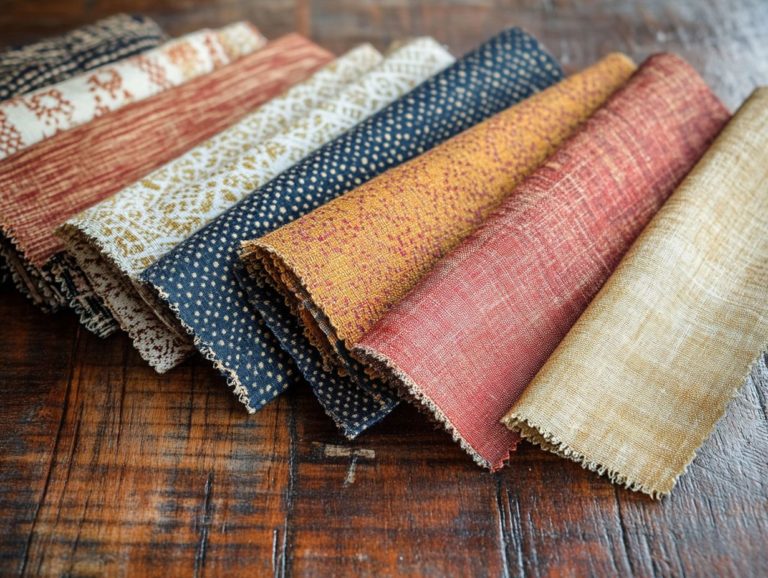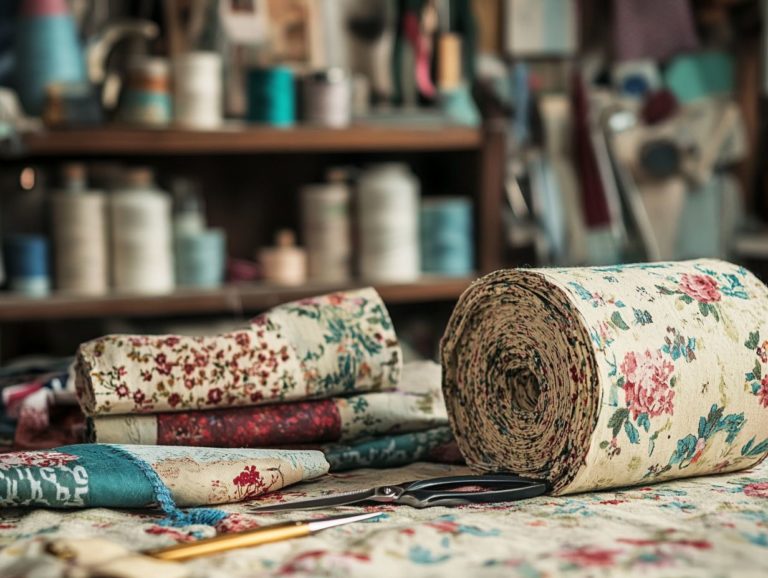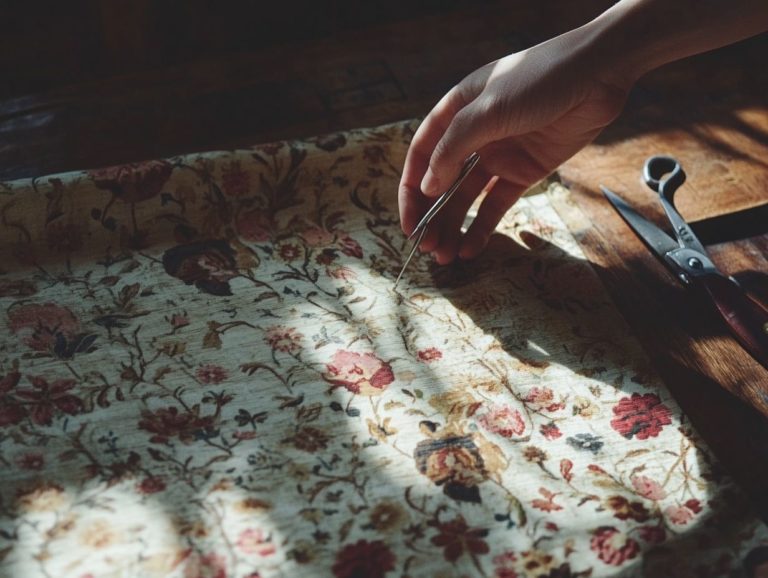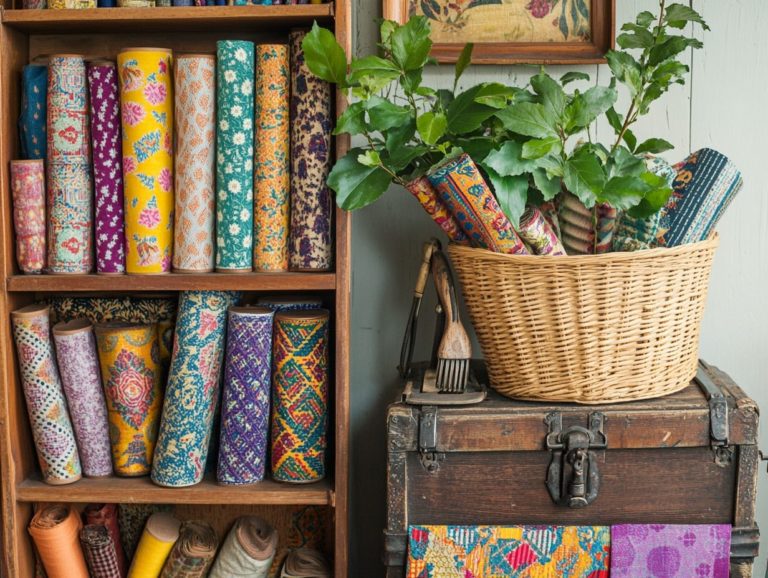How to Identify High-Quality Vintage Fabrics
Vintage fabrics exude a unique charm, steeped in history and character. This makes them irresistible to designers and craft enthusiasts alike. This article delves into what defines vintage fabrics and highlights their key characteristics, equipping you to recognize high-quality pieces.
From identifying popular types to evaluating their condition and care, expert tips will elevate your fabric-hunting journey. You will also find out where to locate these hidden gems and how to preserve them for years to come. Get ready to uncover the fascinating world of vintage fabrics!
Contents
- Key Takeaways:
- Understanding Vintage Fabrics
- Identifying High-Quality Vintage Fabrics
- Common Types of Vintage Fabrics
- Tips for Evaluating Vintage Fabrics
- Where to Find High-Quality Vintage Fabrics
- Caring for Vintage Fabrics
- Frequently Asked Questions
- What are the characteristics of a high-quality vintage fabric?
- How can I determine the age of a vintage fabric?
- What should I look for when checking the condition of a vintage fabric?
- Are there any specific labels or markings I should look for on vintage fabrics?
- Can I test the durability of a vintage fabric before purchasing it?
- How can I tell if a vintage fabric is worth its price?
Key Takeaways:

- Learn the characteristics of vintage fabrics, including age, rarity, and quality.
- Focus on texture, weight, and weave when identifying fabrics.
- Popular vintage fabrics include silk, rayon, and linen, each having unique qualities and uses.
Understanding Vintage Fabrics
Understanding vintage fabrics is crucial for enthusiasts or collectors who value the artistry and craftsmanship woven into these fine fabrics. Vintage fabrics encompass a diverse range of materials, each showcasing distinctive characteristics that set them apart from contemporary options.
These fabrics often narrate a story, capturing the fabric-making techniques and cultural backgrounds of their era, making them invaluable assets for your vintage clothing and upholstery fabric endeavors.
Defining Vintage Fabrics and Their Characteristics
Vintage fabrics are exquisite textiles that are at least 20 years old. They are distinguished by unique characteristics that echo the era from which they originate. You will often encounter beautiful materials like jacquard woven designs or cotton-linen blends.
These textiles frequently boast intricate textures, vibrant colors, and distinctive patterns. Each tells a story about the time and place of their creation. Imagine the soft, faded hues of floral prints or the ornate motifs found in brocade, evoking a sense of nostalgia that many modern fabrics simply can’t capture.
Understanding proper fabric identification is key for enthusiasts and collectors alike. It allows you to appreciate the craftsmanship and historical significance behind each piece. By recognizing the specific qualities of vintage textiles, you enhance their aesthetic appeal and gain deeper insight into fashion history and societal trends. For those interested in preserving these treasures, exploring the best vintage fabric restoration techniques can be invaluable.
Identifying High-Quality Vintage Fabrics
Identifying high-quality vintage fabrics is essential for you as a collector or crafter. You want to ensure your investment is in authentic, durable textiles pieces that not only showcase exquisite craftsmanship but also stand the test of time.
Factors to Consider
When evaluating high-quality vintage fabrics, several key factors come into play, including the type of material, craftsmanship, and overall condition. This is especially important when considering its potential for vintage clothing.
Pay close attention to fabric types such as silk, cotton, linen, and wool. Each material brings unique qualities that influence durability and aesthetics. For example, silk boasts a luxurious sheen perfect for elegant attire, while cotton is renowned for its breathability and long-term comfort.
By examining the weaving techniques, patterns, and colorfastness, you gain valuable insights into the fabric’s longevity and visual appeal. Keeping these elements in mind allows you to truly appreciate the intricacies that define high-quality vintage textiles. For those interested in sourcing these fabrics, knowing where to find authentic vintage fabrics can ultimately lead to more informed purchasing decisions.
Common Signs of Quality
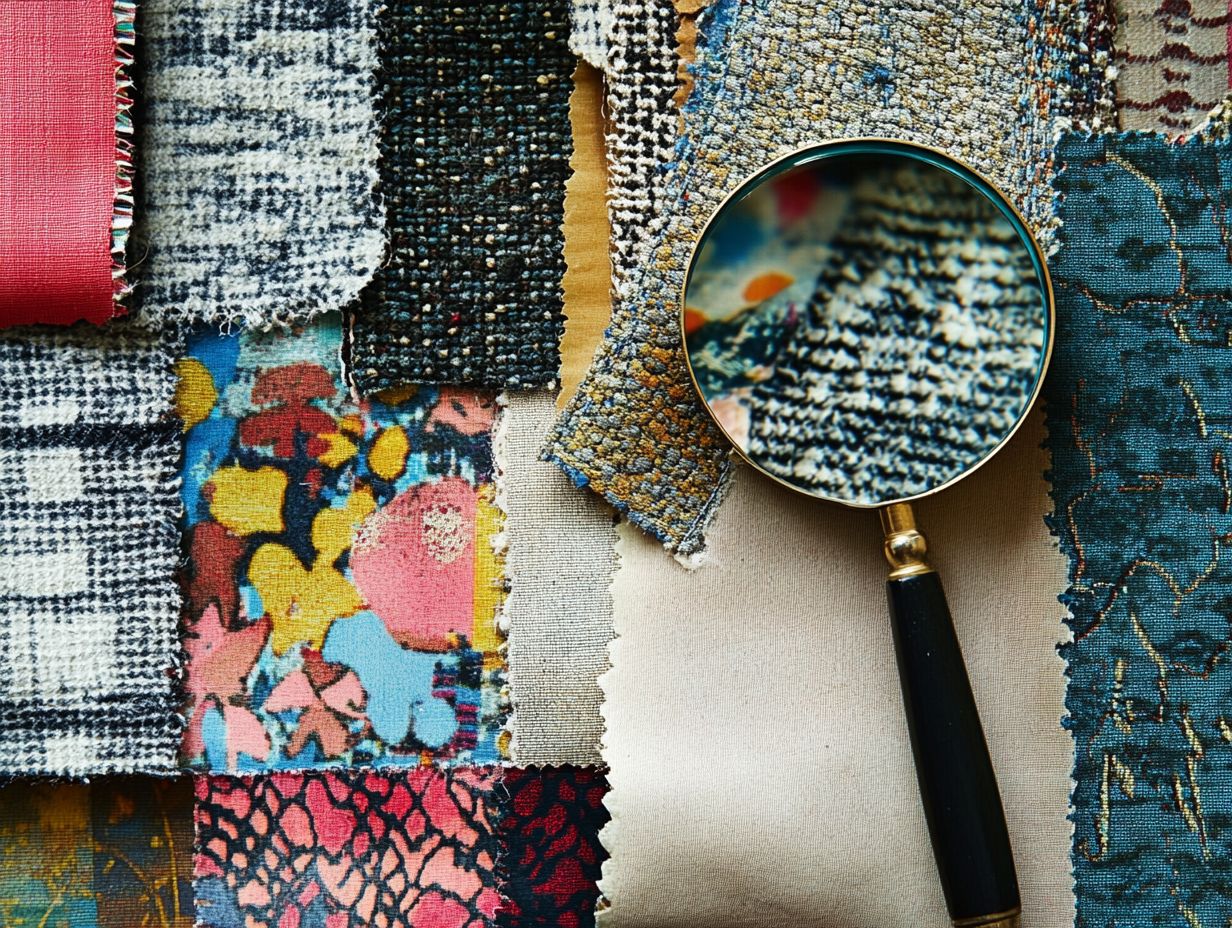
You can identify signs of quality in vintage fabrics through careful examination. This includes performing burn tests a method to check fabric types by burning a small piece to see how it reacts and assessing the overall feel and appearance of these beautiful textiles.
These indicators are essential for anyone passionate about collecting, as they can improve the value and enjoyment of your collection.
A high-quality fabric should feel substantial yet soft to the touch, with a weight suggesting durability. The weave ought to reflect uniformity and precision.
Visually, the richness of color and the presence of intricate patterns often signal superior craftsmanship. Conducting a burn test can help you uncover the fiber content, allowing you to tell the difference between natural and synthetic fibers, each carrying its own historical significance. To delve deeper into this topic, consider exploring understanding different vintage fabric weaves.
Check out these tips to easily spot quality vintage furniture! By focusing on these characteristics, you’ll be ready to snag the best finds and steer clear of low-quality imitations.
Common Types of Vintage Fabrics
Vintage fabrics encompass a rich variety of materials, each offering distinct textures and patterns that have captured the hearts of enthusiasts. You ll find everything from the cozy embrace of barkcloth to the luxurious feel of lightweight satin, alongside sheer gauzy textiles adorned with enchanting floral and geometric designs.
Each fabric tells its own story, inviting you to explore the charm of yesteryears.
Overview of Popular Vintage Fabrics
Exploring the world of popular vintage fabrics reveals a treasure trove of materials that have truly stood the test of time. This includes barkcloth, cotton linen, jacquard woven textures, and lightweight options like crepe chiffon.
Take barkcloth, for instance. Its vibrant patterns and rich texture were all the rage in mid-20th century homes, often gracing upholstery and curtains with lively charm.
Then there’s cotton linen, a summer staple that perfectly balances breathability with style. It’s the go-to choice for fashionable dresses that embody a casual yet sophisticated vibe.
Jacquard woven fabrics, with intricate patterns, have been favorites in formal wear and home d cor, adding a touch of elegance that never goes out of style.
And let s not forget lightweight crepe chiffon, which brings a delicate, flowing quality to garments, making it a highly coveted option for evening wear.
Each of these fabrics enhances vintage clothing and continues to inspire contemporary design sensibilities.
Tips for Evaluating Vintage Fabrics
When evaluating vintage fabrics, having a set of practical tips can enhance the experience. This approach ensures that you discover soft, luxurious textiles that align perfectly with your standards and expectations.
Expert Recommendations
When selecting vintage fabrics, it’s essential to heed expert recommendations. Understanding fabric types and knowing what to seek for that soft, luxurious feel is key.
To cultivate this level of discernment, familiarize yourself with a variety of textiles, as each carries its own distinct qualities and rich history. Experts suggest examining not only the visual appeal but also the tactile sensations of materials like silk or linen, and learning how to work with delicate vintage fabrics, paying close attention to their weight and drape.
Note subtle details, such as seams and finishes, which can reveal a fabric’s age and craftsmanship. For those interested in sourcing high-quality materials, check out the best vintage fabric resources online. Be cautious of overly worn or damaged items, as these can compromise both the aesthetic and durability of your selection.
Where to Find High-Quality Vintage Fabrics
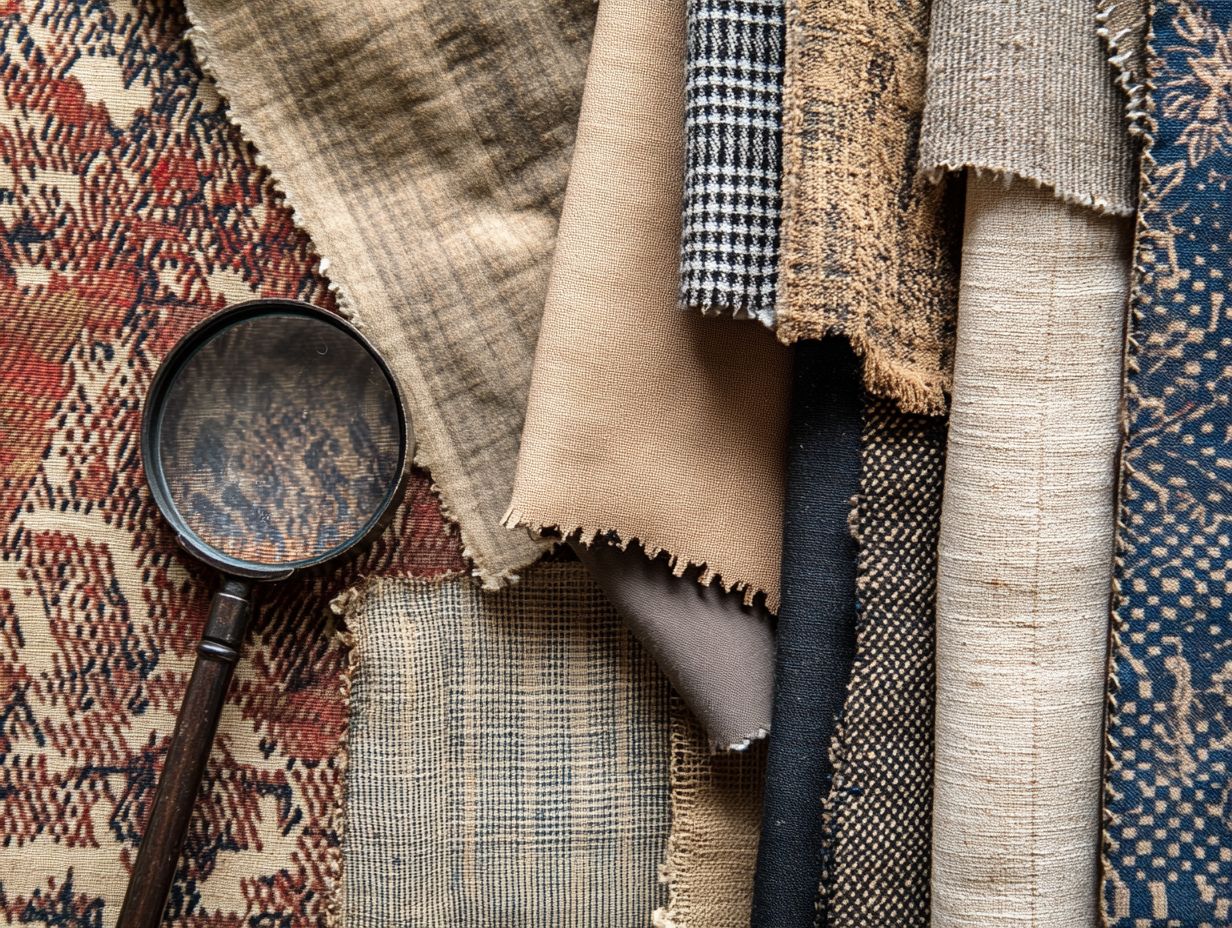
Understanding where to source high-quality vintage fabrics is crucial for collectors and fashion aficionados eager to enhance their vintage collections with authentic, durable textiles.
Start your treasure hunt today and elevate your collection!
Best Places to Shop for Vintage Fabrics
The finest places to shop for vintage fabrics include dedicated vintage shops, online marketplaces, and specialized fabric fairs that curate unique textile collections.
These venues offer a treasure trove of options, each exuding its own distinctive charm. Vintage shops often feature knowledgeable staff who can share insights on the history and quality of the fabrics. This makes them an ideal choice for anyone new to collecting.
Online marketplaces bring the enchanting world of vintage textiles right to your fingertips. This allows for broader exploration without ever having to leave your home.
Fabric fairs let you engage directly with sellers, giving you a deeper understanding of each textile’s story. When sourcing vintage fabrics, it’s essential to choose wisely, considering not just the visual appeal but also the durability and potential for your creative projects. To enhance your knowledge, explore understanding different types of vintage furniture fabrics.
Caring for Vintage Fabrics
Caring for vintage fabrics helps keep them beautiful and lasting for years. It involves thoughtful storage and maintenance practices that ensure these cherished textiles remain in impeccable condition.
By following these guidelines, you can safeguard their beauty for generations to come.
Tips for Proper Storage and Maintenance
Proper storage and maintenance are essential for ensuring your exquisite fabrics maintain their quality over time. This protects them from deterioration and discoloration.
To achieve this, keep these textiles in a stable environment where the temperature stays steady, ideally between 60-75 F (15-24 C). High humidity can invite mold and mildew, so aim for levels around 40-50%.
Be mindful of light exposure, especially from direct sunlight, as it can quickly dull vibrant colors. Storing your fabrics in opaque containers or wrapping them in acid-free tissue paper is a wise choice.
Regularly check for pests and give them a gentle dusting from time to time. These practices will significantly contribute to the long-term preservation of your treasured pieces.
Check out the video above for more tips on vintage fabric care!
Frequently Asked Questions
Here are some common questions about vintage fabrics:
What are the characteristics of a high-quality vintage fabric?
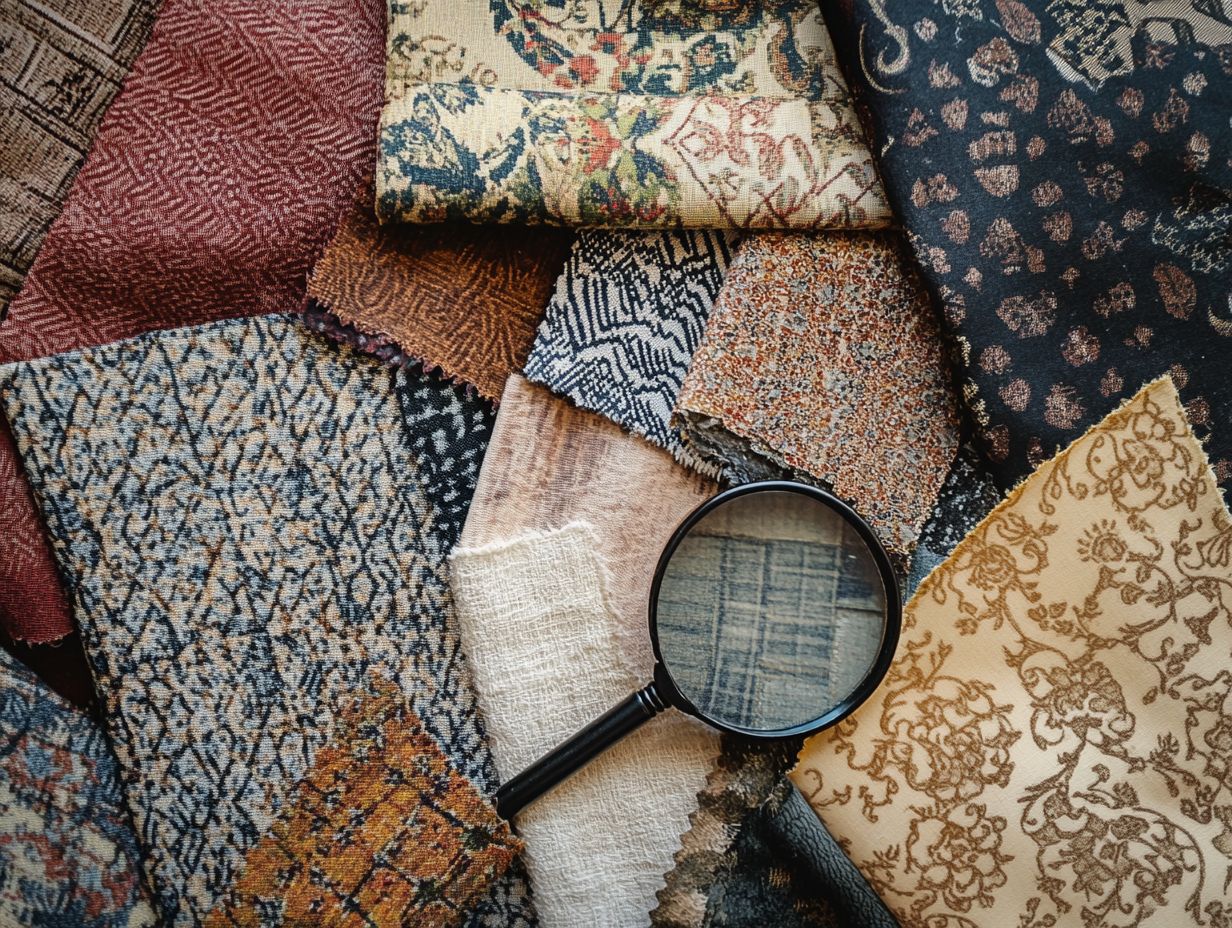
High-quality vintage fabrics are typically made with natural fibers such as cotton, silk, or wool. They also tend to have a smooth texture, even coloration, and minimal flaws or imperfections.
How can I determine the age of a vintage fabric?
One way to determine the age of a vintage fabric is by examining its print or pattern. Prints and patterns often go in and out of fashion, so a fabric with a popular print from a certain era can help place its age.
What should I look for when checking the condition of a vintage fabric?
When examining a vintage fabric, look for signs of wear and tear, such as fading, discoloration, or holes. Also, check the fabric’s seams and edges for any fraying or loose threads, as this can indicate a lower quality fabric.
Are there any specific labels or markings I should look for on vintage fabrics?
Yes, there are certain labels and markings that can indicate a vintage fabric’s quality. Look for labels that specify the fabric’s content, country of origin, and care instructions. Some vintage fabrics may also have a manufacturer’s stamp or logo on them.
Can I test the durability of a vintage fabric before purchasing it?
Yes, you can perform a simple durability test by gently pulling on the fabric in different directions. A durable fabric should not stretch too much and should be able to withstand some gentle tugging.
How can I tell if a vintage fabric is worth its price?
The value of a vintage fabric depends on its rarity, condition, and quality. To determine if it’s worth its price, research similar fabrics and their prices, while also considering the fabric’s overall condition and quality.
Explore your vintage fabric options today and start your collection!


